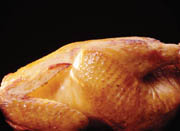
NFPA filed an omnibus petition to expand irradiation applications to multi-ingredient foods, RTE meats, shellfish, hot deboned meat and a wide number of other foods currently excluded from the list of allowed uses. Filed in October 1999 under the FDA's "expedited review concept," the petition has cleared several hurdles in the review process, but it ran into problems with furans. FDA researchers found carcinogenic furans in "the low parts per billion level" in apple juice exposed to radiation, according to George Pauli of the FDA's Office of Food Additive Safety.
FDA researchers subsequently discovered even higher levels of furan in a wide variety of heat-processed foods, including baby food, Pauli reported. Those findings are under review by the FDA's Food Advisory Committee and Dietary Supplements Subcommittee.
Meanwhile, the commercial landscape for food irradiation remains grim. According to Marshall Cleland, head of Ion Beam Applications, the firm's Bridgeport, N.J., facility, which was built exclusively to irradiate food products, is devoting all of its production time to screening Congressional and White House mail for anthrax. Surebeam Corp., the San Diego spin-off of Titan Corp. that operated irradiation facilities in Los Angeles, suburban Chicago and Sioux City, Ia., entered Chapter 7 bankruptcy liquidation early this year.